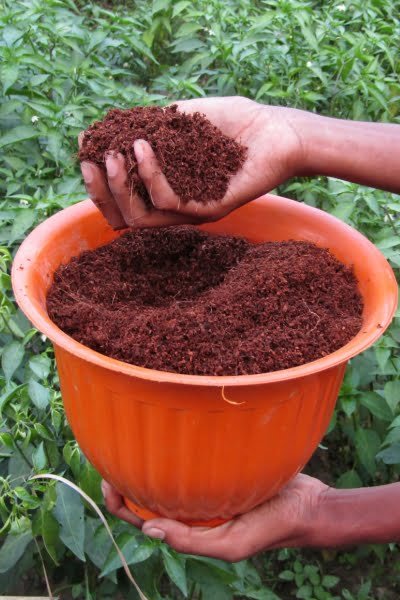In the gardening world, there’s a hidden gem that’s changing the game – Cocopeat. It’s eco-friendly, versatile, and a real game-changer for green thumbs. Never heard of it? Let’s dive into the world of Cocopeat, discover its perks, and see how it can revamp your gardening adventure.
Check out Circle Garden Design: Crafting Elegance in Your Outdoor Click here...
What is Cocopeat?

Cocopeat, also known as coconut coir or coco coir, is a natural fiber derived from coconut husks. It’s a byproduct of the coconut industry, making it a green choice for gardeners. With its fine texture and impressive water-holding capacity, it’s the perfect soil conditioner and growing medium.
The Environmental Edge
Cocopeat’s standout feature is its eco-friendliness. Unlike traditional peat moss, which comes from bogs, cocopeat is sourced from renewable coconut husks. This makes it a sustainable choice that doesn’t harm fragile ecosystems.
Cocopeat vs. Peat Moss: The Showdown
Let’s pit cocopeat against its more conventional counterpart, peat moss, and see how it fares.
Water Retention Abilities
Cocopeat boasts remarkable water-holding abilities, capable of retaining 8-9 times its weight in water. This ensures your plants remain well-hydrated, even during scorching, arid spells. In contrast, peat moss falls short when it comes to water retention.
pH Levels
Cocopeat is pH-neutral, making it a versatile choice for a wide range of plants. Peat moss, while effective, tends to be slightly acidic, which may not suit all plants.
Renewability
As we’ve already mentioned, cocopeat comes from coconut husks, a renewable resource. Peat moss, however, is harvested from bogs, a process that depletes these unique ecosystems.
Check out Electroculture Gardening: Boosting Plant Growth with Electricity Click here...
Using Cocopeat in Your Garden
Now that we’ve established the benefits of cocopeat, let’s delve into its practical uses in your garden.
Soil Amendment
Cocopeat can be mixed with garden soil to improve its structure. It enhances aeration, which is crucial for root development, and helps the soil retain moisture. Simply mix it with your soil, and you’re on your way to healthier plants.
Seed Starting Medium
Cocopeat is an excellent medium for starting seeds. Its fine texture ensures good contact between the seeds and the growing medium, promoting germination.
Mulch Magic
Applying cocopeat as mulch around your plants helps control weeds, conserves soil moisture, and maintains a consistent soil temperature. Plus, it looks great in your garden!
Cocopeat in Hydroponics
Hydroponics enthusiasts, this one’s for you. Cocopeat is a popular choice in hydroponic systems, thanks to its water retention and root support capabilities.
Hydroponic Growing Medium
When used in hydroponics, cocopeat provides the right balance of water retention and aeration, creating an ideal environment for plants to thrive without soil.
Eco-Friendly Hydroponics
For those aiming for an eco-friendly hydroponic setup, cocopeat is an excellent alternative to other mediums that might not be as sustainable.
Check out Maximizing Soil Bacteria for Thriving Gardens Click here...
Tips for Using Cocopeat Effectively
Cocopeat is fantastic, but like any garden tool, it’s essential to know how to use it correctly.
Rehydration Process
Prior to use, cocopeat should undergo rehydration to reach the desired moisture level. Be ready for its significant expansion when water is added – it’s a transformation worth noting.
Balancing pH
Even though cocopeat is pH-neutral, your water source may not be. It’s essential to test your water’s pH and make adjustments as necessary to maintain ideal growing conditions.
The Future of Gardening: Cocopeat
As cocopeat’s wonders become increasingly known among gardeners, it’s poised to take on a more prominent role in shaping the future of gardening.
Sustainable Gardening
In a time when environmental responsibility is paramount, cocopeat symbolizes sustainability and has the potential to be a cornerstone in shaping the future of gardening practices.
Higher Yields
By harnessing cocopeat’s potential, you can anticipate bountiful harvests and healthier plants – a dream come true for every gardener.
Cocopeat is a game-changer for gardeners at every skill level. Its eco-friendliness, water retention prowess, and adaptability make it an essential tool in your gardening arsenal. Whether you’re nurturing a backyard garden or delving into the world of hydroponics, cocopeat has the power to transform your gardening journey. Embrace cocopeat, and witness your garden thrive like never before.
Check out Baking Soda Is A Gardener’s Best Friend Click here...
FAQs about Cocopeat
- Is cocopeat the same as coconut coir? No, cocopeat is often referred to as coconut coir, but it specifically refers to the fiber extracted from coconut husks, while coconut coir can encompass various coconut-derived products.
- Can I use cocopeat in my indoor plants? Absolutely! Cocopeat is an excellent choice for indoor plants due to its moisture retention and aeration properties.
- How often should I water my plants when using cocopeat? The frequency of watering depends on the specific needs of your plants and the environmental conditions. Cocopeat retains moisture well, so be mindful not to overwater.
- Is cocopeat suitable for all types of plants? While cocopeat is versatile, some plants may prefer different soil conditions. It’s best to research the specific requirements of your plants before using cocopeat.
- Can I use cocopeat as a standalone growing medium? Yes, cocopeat can be used as a standalone growing medium, especially for hydroponics. However, it’s often mixed with other substrates for traditional gardening.
Pingback: How to Build a Worm Bin: A DIY Guide for Vermicomposting
Pingback: Buttercup Flowers: Discovering Their Simple Charm